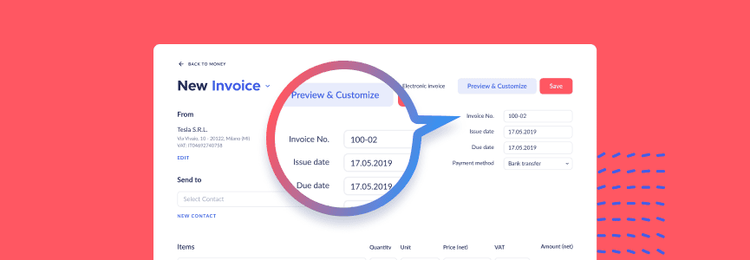Direct debit — what is it and why was it introduced as a payment method? Small businesses are in dire need of a reliable method of collecting payments. Overdue payments cause cash flow constraints, which can be a serious problem for companies that provide services on an ongoing basis. Direct debit can be a good solution in this situation. Let’s take a closer look at this payment method, and the features and benefits that can help to run a business smoothly.
Direct Debit: Basic Info
What Is Direct Debit?
A direct debit is an instruction from a customer to their bank which allows a third-party to receive money from their account. However, this works only if the bank has been given advance notice of the amounts and dates of collection.
The direct debit scheme is a popular payment method in Europe, whereby customers use it to authorize merchants or organizations to withdraw funds from their bank accounts. All Direct Debit payments belong to SEPA Direct Debit (Single Euro Payments Area). This is a central network that handles several different types of electronic payment. Direct debiting is typically used to make recurring payments for things such as credit card bills, utility bills, recurring retainers, and installment payments. These payments are typically made on a monthly basis, and a direct debit ensures that they are paid on time, every time.
Why Direct Debit Is Useful
When a small business has a problem with delayed payments it can reduce their working capital. This can lead to serious debt and, in the worst case, even bankruptcy. One effective way to prevent cash flow problems is to provide a payment method that puts you in control. It should be a method that allows you to determine when you get paid and how often. This is where direct debit comes to the rescue.
In case you are looking for help, we provide additional information on our site. Finom customers can set regular automatic payments or simply schedule a one-time payment for a specific date and time.
Direct Debit Benefits for Business
- Gaining Your Customers’ Trust. If you are a business that accepts direct debit payments, you will be subject to close scrutiny and monitoring by the banks. This constant monitoring will make your business more transparent, which will allow you to gain the trust of your customers.
- Getting Payments on Time. Direct debit helps business owners to receive payments on time, preventing the risks and problems associated with delayed payments.
- Increased Customer Retention. Direct debits make it easy for customers to pay their bills on time, which can reduce the likelihood of late or missed payments and improve customer satisfaction.
- Cash Flow Control. Direct debit handles payment for the services and products you offer. This leads to improved cash flow which, in turn, leads to healthy working capital. As a result, you can manage your business smoothly.
- Easy Set Up. The ease of setting up and the fact that the customer doesn't have to make a regular payment manually every time one is due makes this payment service a must for all businesses. By giving your customers the option of direct debit, you make it easier for them to pay you with minimal intervention, and that will be a huge benefit for doing business with you.
- Direct Debit Guarantee. A direct debit guarantee is a set of protocols followed by banks that accept direct debit instructions. These rules basically favor customers and prevent customers from being liable for improper payments. Businesses that use the direct debit scheme must be very careful about the amounts and dates of payments they initiate, because the direct debit guarantee refunds clients quickly in case of a payment error.
- Improved Data Security. Direct debits are processed through the banking system, which generally offers a high level of security and protection against fraud.
- Environmentally Friendly. Direct debits reduce the need for paper, which is more environmentally friendly.
- Reduced Risk of Chargebacks and Disputes. Direct debits offer less risk of chargebacks and disputes as the payment is authorized in advance by the customer.
How Does Direct Debit Work?
A direct debit works by allowing a business or organization to collect payments from a customer's bank account automatically. The process typically involves the following steps:
- The customer gives permission: The customer must first provide written or electronic authorization to the business or organization to collect payments via direct debit. This authorization is known as a "direct debit mandate."
- The business or organization sets up the direct debit: Once the customer has given permission, the business or organization will set up the direct debit by providing the customer's bank account details to their own bank.
- The payment is collected: On the agreed-upon date, the business or organization's bank will collect the payment from the customer's bank account. The amount and the date of the payment are agreed upon by both the customer and the business.
- Confirmation of payment: The customer's bank will send a confirmation of the payment to the customer, and the business or organization will also receive a notification of the payment.
- The customer has the right to cancel: The customer has the right to cancel the direct debit at any time, and can request a refund for an unauthorized payment.
SEPA Direct Debit in More Detail
You can find direct debits in such countries as Germany, Italy and France. Direct debits are subject to the rules of each country and are generally limited to domestic transactions in those countries. An exception in this regard is SEPA, which since November 2010 allows cross-border (and domestic) direct debits denominated in euros. SEPA Direct Debit is a pan-European system that authorizes business owners to debit their customers’ accounts in 34 SEPA countries and related territories.
SEPA is a European Union initiative to manage payments in the Eurozone. The main purpose is to make European payments available and easy to conduct by developing a single market for euro payments.
Before receiving any payments from the customer's bank account, a direct debit mandate must be signed. A direct debit mandate gives service providers written permission to collect payments from customers' bank accounts. You can’t deal with their accounts until the mandate is signed and agreed to by the customer.
Setting Up a Direct Debit
To begin accepting funds from a customer's account, you should complete the following steps.
- Prepare a mandate for your customer to sign. The mandate must contain the information about account holder’s name, customer's BIC and IBAN, full postal address, contact details, payment date and payment account. You can collect this data by sending a hard copy or an online form for the customer to complete and return to you. You can also collect customer data by phone, but the scenario must be approved by the bank.
- Get a mandate from the customer and send it to your bank. Most banks generally take about 4-6 days to activate the mandate.
- As soon as the mandate is activated, you must notify your customer 14 calendar days before the actual payment is due, unless you agreed on a shorter notice period with your client. If you are collecting regular payments, you only need to provide one payment notice indicating the frequency and amount. If a payment fails, speak to your customers to clarify the situation.
Direct Debit — A Convenient and Easy Payment Method
Direct debit is the simplest and smartest payment method, providing you with complete control over your cash flow, as it enables automatic payments. The low risks and minimal need for manual intervention make it attractive to both customers and businesses.
If you provide recurring services and search for the most convenient payment method, direct debit is a great choice. It can help your customers to pay regular amounts and assist you in maintaining a stable cash flow.
Read our other articles on topics such as CVV codes and virtual bank cards.
Last articles

The Best CRMs for Small Businesses: How to Find Your Perfect Software

Finom Raises €50M in Series B Funding Led by General Catalyst and Northzone

Passkeys: Powering Finom’s Security Upgrade

Pro Forma Invoice: What It Is and Its Meaning

PO vs. Invoice: What Are the Differences Between These Financial Terms?

Invoice Number: What Is It and Why Should I Generate One?

CVV Code: The Guardian of Your Financial Security


